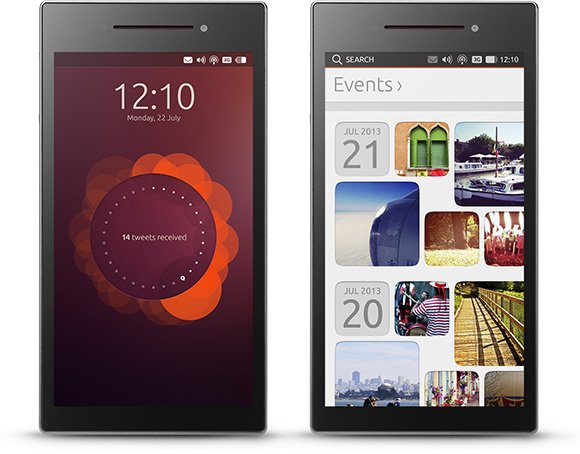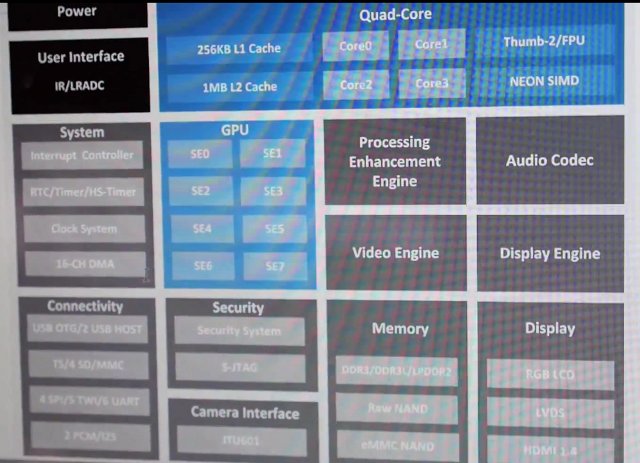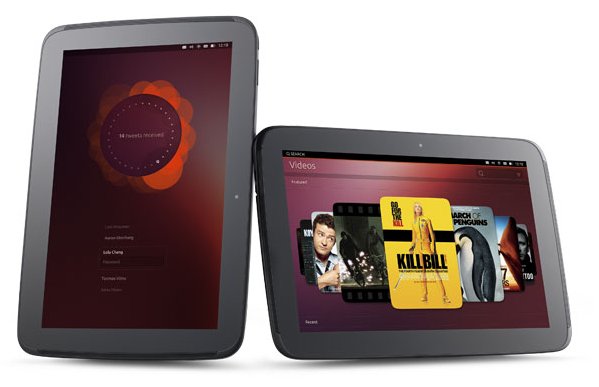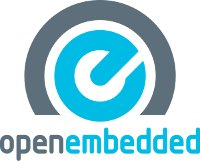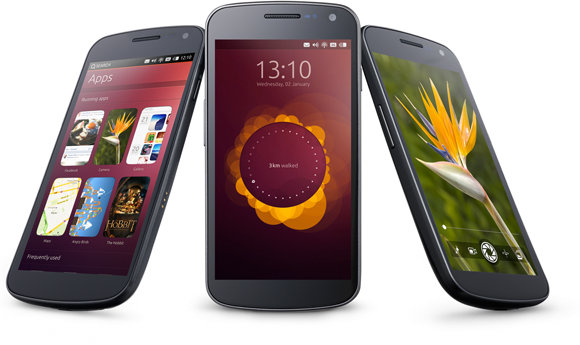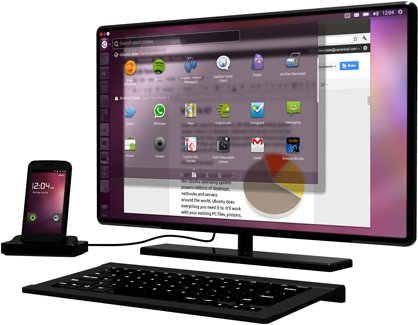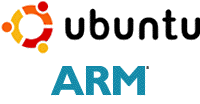Canonical has announced Ubuntu for Phones and Ubuntu for Tablets at the beginning of the year, with the goal of bringing Ubuntu operating system to mobile devices, and transform high-end devices into the new PC when they are connected to an HDMI display. It turns out mobile phone manufacturers may not be ready to take the risk launching a completely new high-end platform to the market, so Canonical decided to leverage the power of crowdfunding but launching an Indiegogo campaign for Ubuntu Edge, a smartphone with hardware specs like no others, capable of running both Android and Ubuntu, and fully replacing your PC when docked. Ubuntu Edge Preliminary/Targeted Specifications: SoC – “Fastest Multicore Processor Available” System Memory – At least 4 GB RAM Storage – 128 GB flash Display – 4.5″ display with the best balance of resolution (720p), dynamic range and color accuracy, covered with sapphire crystal glass (Unscratchable, […]
AllWinner Announces A31s Processor for Phablets, Hints about Ubuntu Devices
AllWinner is currently a Mobile World Congress 2013, and Charbax had the chance to interview Eva, manager at AllWinner, and learn more about new processors, and future plans by the company. They spent some time discussing about AllWinner A31 and AllWinner A20 quad and dual Cortex A7 processors, but since we’ve know about those for a while I’ll skip this part. The most interesting part is about AllWinner A31s, a cost down version of A31, specifically designed for phablets (smartphones with 5″ to 7″ screens). Like AllWinner A31, AllWinner A31s is also a quad core Cortex A7 processor with PowerVR SGX544MP2 GPU (8 shader engines) and the following specifications: CPU – ARM Cortex-A7 Quad-Core with 256KB L1-Cache/1MB L2-Cache GPU – POWERVR SGX 544MP2 with 8 logic cores. OpenGL ES2.0, Open CL1.x and DX 9_3 compliant. Memory 32-bit Dual-Channel LPDDR2/DDR3/DDR3L Controller, 8-bit NAND FLASH Controller with 64-bit ECC Video UHD H.264 […]
Canonical Unveils Ubuntu on Tablets
Yesterday, Ubuntu.com displayed a time counter for an announcement reading “Tic Toc Tablet Time” that ended being about Ubuntu on Tablets, and not an HTC Tablet running Ubuntu as some blogs speculated, as both companies had a timer counter set to expire at the same time for separate, and unrelated, announcements. The interface looks very much like Ubuntu for Phones with a similar “Welcome Screen”, except multiple users are supported, no icons (except for apps), and you can swipe around the 4 edges to access the dash, opened applications, notifications, and more. Canonical highlights 5 key features for Ubuntu on Tablets: Real multitasking – Run mobile and tablet apps at the same time on the same screen Secure multi-user Voice controlled HUD productivity Edge magic for cleaner apps – As I said previously no buttons, you control eveything from the edges. Content focus – Messages and media are easily accessible […]
ARM 64-Bit Bootstrapping with OpenEmbedded – ELCE 2012
Marcin Juszkiewicz, software engineer at Canonical, explains how ARMv8 was bootstrapped with OpenEmbedded with fast model simulation at the Embedded Linux Conference in Barcelona on November 7, 2012. Abstract: The time has come – there is ARM 64-bit architecture right behind a corner. In this talk I will present how OpenEmbedded was used to build root filesystem for fast models simmulating not-yet-existing hardware. Presentation is targeted at developers interested in cross compilation, handling new architectures in existing projects. Agenda of the talk: Introduction to Aarch64 – aka arm64 or ARMv8, the new 64-bit version of the ARM architecture Introduction to OpenEmbedded – Build system capable to build everything from package to whole distribution with repositories First steps: Create own layer for AArch64 stuff Adding basic support into OE classes Machine definition Toolchain – Based on gcc 4.7 + ARM patches Build results – As of October 2012, 800 packages have […]
Canonical Announces Ubuntu for Phones
Canonical has just announced the Ubuntu for Phones platform that will allows users to have similar experience on desktops (Ubuntu Desktop), TVs (Ubuntu TV) and smartphones, avoiding the need to learn 2 different platform for the desktop and mobile devices. The user interface replaces the “Lock screen” with the “Welcome screen” (As shown in the middle of the picture above), which shows notifications and user data as you turn on your device. The user interface mostly eliminate buttons, and you can access features by swiping the edge of the phone. A swipe on the left edge will show the dash bar, giving access to most used apps and dash search, a swipe on the right edge will cycle through your opened apps, a swipe at the top will give access to notifications and allow changing settings right from there, and a swipe at a button will allow you to customize […]
Ubuntu on ARM: Improvements and Optimizations Done by Linaro – ELCE 2012
Ricardo Salveti de Araujo, developer platform lead for Linaro, displays the improvements Linaro have added to Ubuntu on ARM. Abstract: Since Linaro’s start, there was a need to have a supported platform for ARM, that could use the Linaro changes, to improve the ARM experience in general and to show the results of the work done by Linaro. In this session, it’ll be presented why Ubuntu was selected as the base platform for Linaro, describing the benefits and the areas Linaro is continuously investing to improve it. It’ll also be described the current state of the platform, showing some of Linaro’s achievements and also how we’re working to support the main SoC boards available, like Panda, Beagle, Origen, iMX53 and Snowball with the latest development by Ubuntu and Canonical, like Ubuntu TV, Phone and Tablet. You can also download the presentation slides. Jean-Luc Aufranc (CNXSoft)Jean-Luc started CNX Software in 2010 […]
Canonical Brings Ubuntu Desktop to Multi-Core Android Smartphones
Canonical is pushing to move Ubuntu beyond Desktop PC, and we’ve already seen some mockups for Ubuntu Smartphones and the recent Ubuntu TV announcement. The Ubuntu smartphone is not there yet, but Canonical has another idea: running Ubuntu Desktop on your multi-core Android smartphone connected to a TV/Monitor via its HDMI or MHL interface, making Canonical, another company joining “your smartphone is your laptop” trend. Ubuntu for Android will provide a full desktop experience and include office software (which apparently is Google Docs…) , web browsers (Chromium and Firefox), an email clients (Thunderbird) and media applications on Android phones docked to a screen and keyboard. Canonical claims the transition between Android and Ubuntu is seamless thanks to tight integration with the Android service layer. Ubuntu and Android share the same kernel. When docked, the Ubuntu OS boots and runs concurrently with Android. This allows both mobile and desktop functionality to […]
The Past, Present and Future of Ubuntu for ARM
David Mandala of Canonical talked at Linux.Conf.Au on 18th of January 2012 about Ubuntu for ARM and the move from netbook to server support. You can read my notes below, or jump at the end of this post to watch the presentation. The Past 2008: Ubuntu decides to only support ARMv7 architecture vs. Debian that supports ARMv4 and above. 2009: Ubuntu release for Freescale i.MX51 (ARMv5 built), and then Marvell ARMAVA with ARMv6 and VFP (ARM floating point unit) support. 2010: April (10.04) The first ARMv7 release for OMAP3 (Beagleboard) with VFP, Thunb2, NEON and SMP for ARM and first netbook edition October (10.10) Pandabord (OMAP4) release with initial device tree support for ARM. Starts work with Linaro. 2011: 11.04 (5th release) – Supports OMAP3 and OMAP4 only. The netbook edition is using Qt, further improvement to device tree, further work with linaro and on the way to the Unified […]


